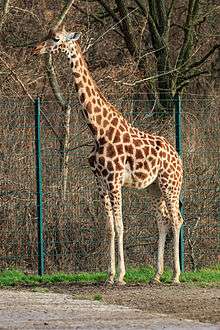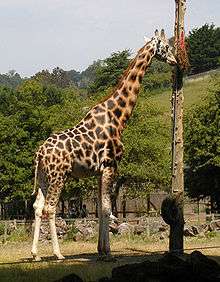Rothschild's giraffe
| Rothschild's giraffe | |
|---|---|
 | |
| Rothschild's giraffe in Tierpark Berlin in Germany | |
| Scientific classification | |
| Kingdom: | Animalia |
| Phylum: | Chordata |
| Clade: | Synapsida |
| Class: | Mammalia |
| Order: | Artiodactyla |
| Family: | Giraffidae |
| Genus: | Giraffa |
| Species: | G. camelopardalis |
| Subspecies: | G. c. camelopardis |
| Trinomial name | |
| Giraffa camelopardalis camelopardis | |
 | |
| Rothschild's giraffe's range in pink | |
| Synonyms | |
|
G.c. rothschildi (Lydekker, 1903) | |
Rothschild's giraffe (Giraffa camelopardalis camelopardis, formerly Giraffa camelopardis rothschildi) was formerly considered a subspecies of a singular Giraffa species, but due to genetic analysis circa 2016,[2] has now been determined to be a conspecific ecotype of the Nubian giraffe (G.c. camelopardis), a subspecies of the Northern giraffe. It is one of the most endangered distinct populations of giraffe, with 1500 individuals estimated in the wild.[2][3]
Taxonomy and evolutionary history
.jpg)
Giraffa camelopardalis rothschildi was named after the Tring Museum's founder, Walter Rothschild,[4] and is also known as the Baringo giraffe, after the Lake Baringo area of Kenya,[5] or as the Ugandan giraffe. All of those living in the wild are in protected areas in Kenya and Uganda.[3] In 2007, Rothschild's giraffe was proposed as actually a separate species from other giraffe and not a giraffe subspecies.[3] In 2016, a comprehensive analysis of all former giraffe subspecies concluded in the existence of four giraffe species, with the Rothschild's giraffe being deemed conspecific with the Nubian giraffe, which had never been analysed before. This resulted in both being composed as a single subspecies as the Nubian giraffe, in addition being added with the two other subspecies (the West African giraffe and the Kordofan giraffe) into the Northern giraffe species.[2]
Characteristics
Rothschild's giraffe is easily distinguishable from other species, subspecies and distinct populations such as the Rhodesian giraffe. The most obvious sign is in the colouring of the coat, or pelt. Whereas the Reticulated giraffe has very clearly defined dark patches with bright-whitish channels between them, Rothschild's giraffe more closely resembles the proper coating of Masai giraffe. However, when compared to the Masai giraffe, Rothschild's ecotype is paler, the orange-brown patches are less jagged and sharp in shape, and the connective channel is of a creamier hue compared to that seen on the reticulated giraffe. In addition, Rothschild's giraffe displays no markings on the lower leg, giving it the impression of wearing white stockings.[4]
Another distinguishing feature of Rothschild's giraffe, although harder to spot, is the number of ossicones on the head. This is the only Giraffa phenotype to be born with five ossicones. Two of these are the larger and more obvious ones at the top of the head, which are common to all giraffes. The third ossicone can often be seen in the center of the giraffe's forehead, and the other two are behind each ear. They are also taller than many other populations, measuring up to 5.88 metres (19.3 feet) tall.[6][7]
Males are larger than females and their two largest ossicones are usually bald from sparring. They usually tend to be darker in colour than the females, although this is not a guaranteed sexing indicator.
Habitat and distribution
Isolated populations of Rothschild's giraffes live in savannahs, grasslands and open woodlands of Uganda and Kenya. They are possibly regionally extinct from South Sudan and northeastern Democratic Republic of the Congo.
Ecology and behavior

Rothschild's giraffes mate at any time of the year and have a gestation period of 14 to 16 months, typically giving birth to a single calf. They live in small herds, with males and females (and their calves) living separately, only mixing for mating.
Threats and conservation
While giraffes in general are classified as Least Concern, Rothschild's giraffe is at particular risk of hybridisation, as the population is so limited in numbers. Very few locations are left where Rothschild's giraffe can be seen in the wild, with notable spots being Lake Nakuru National Park in Kenya[8] and Murchison Falls National Park[9] in northern Uganda.
In captivity
Various captive breeding programmes are in place — notably at the Giraffe Centre in Nairobi, Kenya — which aim to expand the gene pool in the wild population of Rothschild's giraffe. As of January 2011, more than 450 are kept in ISIS registered zoos (which does not include the Nairobi Giraffe Centre), making both it and the reticulated giraffe the most commonly kept phenotypes of Giraffa.[10]
References
- ↑ Fennessy, J. & Brenneman, R. (2010). "Giraffa camelopardalis ssp. rothschildi". IUCN Red List of Threatened Species. Version 2012.1. International Union for Conservation of Nature. Retrieved 24 June 2012.
- 1 2 3 Julian Fennessy; Tobias Bidon; Friederike Reuss; Vikas Kumar; Paul Elkan; Maria A. Nilsson; Melita Vamberger; Uwe Fritz; Axel Janke (September 8, 2016). "Multi-locus Analyses Reveal Four Giraffe Species Instead of One". Current Biology.
- 1 2 3 "Not one but 'six giraffe species'". BBC News Online. 21 December 2007. Retrieved 27 December 2007.
- 1 2 Reed, Christopher (11 October 2005). "Obituary - Betty Leslie-Melville". The Guardian. London. Retrieved 19 April 2007.
- ↑ Eric O. Odada. "Lake Baringo" (PDF). Retrieved 7 March 2010.
- ↑ Dagg, A.I.; Foster, J. B. (1982). The Giraffe. Its Biology, Behavior, and Ecology (with updated supplementary material). Malabar, Florida: Krieger Publishing Company.
- ↑ Nowak, R. M. (1999). Walker's Mammals of the World. Volume 1. Baltimore, USA and London, UK: The Johns Hopkins University Press. pp. 1086–1089.
- ↑ "Lake Nakuru National Park". UNESCO. Retrieved 7 March 2010.
- ↑ "National Parks & Safaris". Uganda Tourist Board. Archived from the original on 10 February 2007. Retrieved 9 May 2007.
- ↑ International Species Information System (2011). Giraffa camelopardalis. Version 12 January 2011.
External links
-
 Media related to Rothschild's Giraffes at Wikimedia Commons
Media related to Rothschild's Giraffes at Wikimedia Commons -
 Data related to Giraffa camelopardalis rothschildi at Wikispecies
Data related to Giraffa camelopardalis rothschildi at Wikispecies
